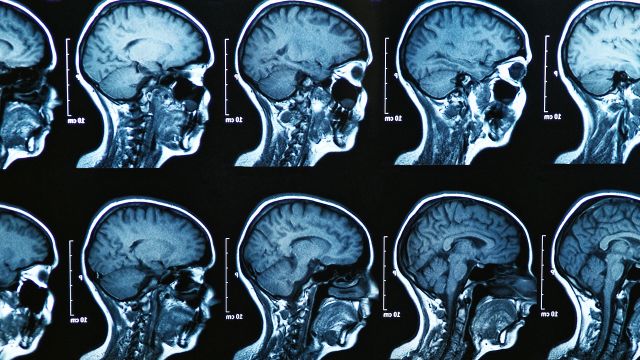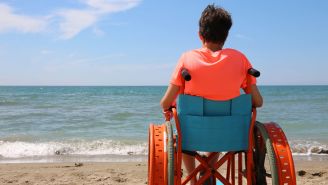Updated on April 22, 2024.
Amyotrophic lateral sclerosis (ALS) is a disease that attacks the nerve cells controlling voluntary muscle movement in the brain and spinal cord. Up to 30,000 people in the United States are affected. As ALS progresses, it kills the body’s nerve cells, resulting in weakened muscles, paralysis, and ultimately death. There is no cure.
The condition is sometimes called Lou Gehrig's disease, due to the widespread attention the baseball legend brought to ALS after his 1939 diagnosis.
Symptoms and progression
The disease begins gradually, with painless muscle weakness. It first affects muscles responsible for speech as well as those in the arms, legs, hands, and feet. Symptoms can include:
- Tripping
- Dropping things
- Unexplained fatigue of limb muscles
- Cramping or twitching
- Laughing or crying uncontrollably
- Voice changes
Over time, weakness and atrophy (or muscle loss) spread to the rest of the body. Signs often begin with stiffness or weakness in one arm or leg, slurred speech, or difficulty swallowing.
Patients diagnosed with ALS eventually lose the ability to walk, stand, and use their arms and legs. As the disease progresses, patients require ventilator support to breathe. Due to weakening respiratory muscles, people affected by ALS often die of respiratory failure three to five years after the arrival of the first symptom.
Despite this prognosis, about 10 percent of individuals diagnosed with ALS live for 10 or more years. Scientist Stephen Hawking, for example, survived more than five decades after being diagnosed with a rare form of ALS in 1963. He passed away in 2018.
How ALS is diagnosed
No one test can diagnose ALS. Healthcare providers (HCPs) begin by assessing a patient’s symptoms and reviewing their medical history. They’ll next run a series of tests. These include electromyography, which detects electrical activity in the muscles, and a nerve conduction study, which assesses the nerves' ability to send a signal. The tests are done to eliminate the possibility of other diseases.
Other tests include repeated neurologic exams, which can help determine whether muscle weakness, atrophy, and other symptoms associated with ALS are getting worse over time. This progression would be an indicator of ALS.
A diagnosis of ALS requires signs of damage to both upper and lower motor neurons that cannot be explained by another illness. Upper motor neurons in the brain send messages to lower motor neurons in the spinal cord. The lower motor neurons, in turn, control the muscles in your body that perform essential functions, like walking and chewing.
In its early stages, ALS can resemble other diseases, including multiple sclerosis, West Nile virus, and HIV. Because of these similarities, it’s often recommended that patients seek multiple medical opinions.
Why do people develop ALS?
The cause of ALS is still unknown, but more than a dozen genetic mutations have been linked to the disease. It’s unclear how these mutations lead to motor neuron degeneration, but research suggests it’s caused by cell defects.
Researchers are also studying factors such as exposure to toxic agents, physical trauma, and chemical imbalances in the body. People with ALS have increased levels of glutamate, a chemical messenger in the brain that can be toxic to nerve cells in excess.
Treatments for ALS
There is no cure for ALS, but the U.S. Food and Drug Administration (FDA) has approved several drugs with the potential to slow disease progression:
- Rilutek (riluzole) was the first ALS drug to be approved, in 1995. It comes in pill form and appears to work in some patients, but it does not reverse damage that has already occurred. Rilutek can prolong the life of some people with ALS by a few months.
- Tiglutik is a liquid form of riluzole, intended to avoid problems with crushing tablets.
- Exservan is an oral-film form of riluzole that can be easier for patients to take if they have problems swallowing.
- Radicava (edaravone) slowed physical decline in ALS patients by 33 percent in one trial.
- Qalsody (tofersen) was approved by the FDA in 2023 to treat ALS linked to mutation in the gene superoxide dismutase 1 (SOD1).
Other drugs and therapies may be prescribed to manage symptoms and keep patients functioning for as long as possible. These include speech and physical therapy, nutritional support, and medications to manage pain, fatigue, muscle spasms, and more. Nuedexta, for example, is an FDA-approved medication that is prescribed for involuntary, uncontrollable episodes of laughing or crying that may affect people with ALS.
The future of ALS
Scientists continue to study ALS, and new treatments are constantly in development. Awareness of the disease received a massive boost in 2014, when an ALS patient named Anthony Senerchia inspired the Ice Bucket Challenge, an online fundraising campaign. Participants posted videos of themselves dumping ice water over their heads in return for donations, while encouraging others to do the same.
The 17 million people who accepted the challenge ultimately raised more than $115 million for the ALS Association, tripling the amount it was able to spend on research compared with 2014. Donations helped fund new treatments, care services, assistive technology, and even the discovery of genes linked to ALS.
The ALS Association continues to fund research, work on federal advocacy, coordinate local support for patients, and help others get involved. The hope is that these efforts can help put an end to this disease for good.







